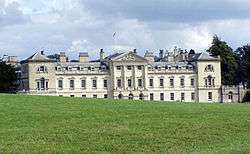Henry Flitcroft
| Henry Flitcroft | |
|---|---|
| Born |
30 August 1697 probably Hampton Court |
| Died |
25 February 1769 (aged 71) Hampstead |
| Nationality | English |
| Occupation | Architect |
| Buildings |
Wentworth Woodhouse Woburn Abbey St. Giles-in-the-fields |
Henry Flitcroft (30 August 1697 – 25 February 1769) was a major English architect in the second generation of Palladianism. He came from a simple background: his father was a labourer in the gardens at Hampton Court and he began as a joiner by trade. Working as a carpenter at Burlington House, he fell from a scaffold and broke his leg. While he was recuperating, the young Lord Burlington noticed his talent with the pencil, and by 1720 Flitcroft was Burlington's draughtsman and general architectural assistant, surveying at Westminster School for Burlington's dormitory, and superintending at the site at Tottenham House. Working life in the inner circle that was driving the new Palladian architecture was an education for Flitcroft.
Flitcroft redrew for publication the drawings for The Designs of Mr. Inigo Jones, published by William Kent in 1727, under Burlington's patronage and supervision. In May 1726 Burlington got his protégé an appointment at the Office of Works, where he worked his way up from Master Carpenter and Master Mason to Comptroller of the King's Works, a prestigious position at the top of the architectural field. Royal commissions came his way in the form of some private projects for junior members of the British Royal Family; namely the Duke of Cumberland. His work for the Duke at Windsor Great Park included creating the Virginia Water Lake.[1]
Flitcroft's hands were constantly occupied with private commissions and, like most professional architects (and unlike virtuoso earls), he did some speculative construction in new-building London streets, supplied stone, and contracted to erect the buildings he was designing.
Major commissions
- Lilford Hall, Northamptonshire: 1740s. At Lilford he designed the interiors.
- St Giles in the Fields, London: 1731–34.
- Ditchley House, Oxfordshire: 1724 onwards. At Ditchley he designed interiors, working in harmonious partnership with William Kent.
- Wentworth Woodhouse, W. Riding, Yorkshire: 1735 onwards. He rebuilt and enlarged the west front and added wings.
- St Giles House, Wimborne St Giles, Dorset: 1740–44. Interiors.
- Stowe House, Buckinghamshire: ca. 1742. The State gallery (attributed).
- Wimpole Hall, Cambridgeshire: 1742–45.
- Stourhead, Wiltshire: 1744–65. Garden temples
- Woburn Abbey, Bedfordshire: 1748–61.
- Milton Hall, Northamptonshire: 1750–51.
Flitcroft built extensively in the West End of London.
Connections with Samantha Cameron and Catherine, Duchess of Cambridge
Samantha Cameron's family own the large Yorkshire estate called Sutton Park. In March 2015, unpublished photographs from the City of Leeds archives revealed that the panelling and mantelpiece in the study of Sutton Park had been designed by Flitcroft in the 1720s. His panelling had been imported from the Morning Room of Potternewton Hall, near Leeds, which was at Newton Park, the ancestral estate of Olive Middleton née Lupton and then installed at Sutton Park. Olive Middleton (d.1936) was the great grandmother of Catherine, Duchess of Cambridge.[2][3][4]
 Wimpole Hall, as remodelled by Flitcroft
Wimpole Hall, as remodelled by Flitcroft The Pantheon, Stourhead
The Pantheon, Stourhead Facade The Pantheon, Stourhead
Facade The Pantheon, Stourhead The temple of Apollo, Stourhead
The temple of Apollo, Stourhead North front, St. Giles-in-the-fields
North front, St. Giles-in-the-fields Looking East, St. Giles-in-the-fields
Looking East, St. Giles-in-the-fields West front, Woburn Abbey
West front, Woburn Abbey West front, Wentworth Woodhouse, the wings were altered later by John Carr
West front, Wentworth Woodhouse, the wings were altered later by John Carr
References
- ↑ Heritage, British. "THE ROYAL ESTATE, WINDSOR: VIRGINIA WATER LAKE AND THE TRIANGULAR BELVEDERE". english-heritage.org.uk. UK Gov. Retrieved September 7, 2013.
- ↑ Laycock, Mike. "Duchess of Cambridge's links with stately home near York revealed". The Press (York) - 17 March 2015. Retrieved 22 May 2015.
Pine panelling from the morning room had then been installed in a room at Sutton Park at Sutton-on-the-Forest, owned by Sir Reginald Sheffield, father of the Prime Minister’s wife, Samantha Cameron. He said the panelling and mantelpiece were saved because they were part of a priceless interior dating from the 1720s, designed by royal architect Henry Flitcroft.
- ↑ A photographic Archive of Leeds, Leodis. "Potternewton Hall, Potternewton Lane". UK Gov. City of Leeds. Retrieved 23 May 2015.
- ↑ Poole, David. "Potternewton Hall, Leeds". Heritage Gazette - 18 March 2015. Retrieved 22 May 2015.
- H.M. Colvin, A Biographical Dictionary of British Architects, 1600-1840 (1997) ISBN 0-300-07207-4
- Heward, John and Taylor, Robert "The Country Houses of Northamptonshire". ISBN 1-873592-21-3
| Court offices | ||
|---|---|---|
| Preceded by Thomas Ripley |
Comptroller of the King's Works 1758 - 1769 |
Succeeded by William Chambers |